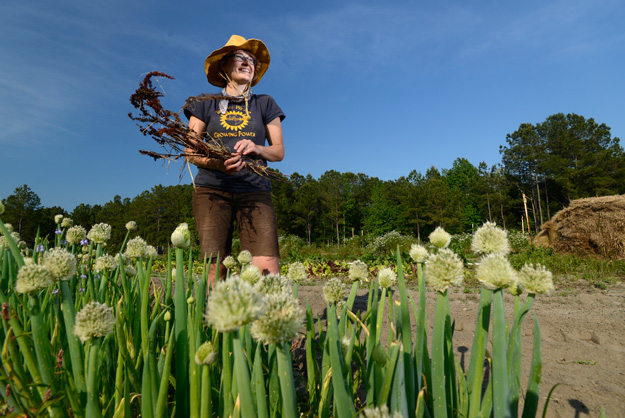Farmer for a Day
Crop mobs send volunteers to help local farms

Like produce, crop mobs have been sprouting up all over the country. The original group started in October 2008 in the Triangle region of North Carolina – a group of young and landless soon-to-be or want-to-be farmers helped harvest sweet potatoes at Piedmont Biofarm in Pittsboro.
Since then, the organization has grown with different groups popping up all over America. Last year, a group was born here in Wilmington.
Brittany Taggart and Nicole Carpenter created the Cape Fear Crop Mob in August. Since then, they have had multiple outings, and even though Carpenter has moved from the area, Taggart continues with her passion.
The unpaid volunteers met at the farm for a day of mulching with hay – fifteen bales to be exact – to cover the farming land, helping prevent weed growth and allowing produce to grow unhindered.
Other mob outings are being researched for the summer months, and, while the places are to be determined, the Cape Fear Crop Mob hopes to fill as many Saturdays as possible at local farms.
Taggart says she wanted a way to bring together the home gardeners and those interested in food.
While in the past it required entire communities to run a farm, the modern-day farmer can use machines, making them more independent.
Nationwide, the number of farms has decreased, but North Carolina has had a surge in smaller farms that focus on sustainability.
 Sustainability is having a resource and finding the best way to use it. That way of farming is more labor-intensive and requires the help of a community once more.
Sustainability is having a resource and finding the best way to use it. That way of farming is more labor-intensive and requires the help of a community once more.
In order for the group to choose a farm to help, it must pesticide-free, organizers said.
The farmers decide what needs to be done, tasks that typically include mulching and weeding.
“Mulching is such a neat process. We’ll cover, say, potatoes with hay. The weeds don’t have any sunlight, so no new weeds can grow, but after a while you’ll see the sprouts of potatoes peaking through to find the sunlight through the hay,” Taggart says.
The groups begin in the morning – about 8 a.m. – and work until early afternoon. Each crop mob ends with a lunch of produce from the farm provided by the owner. At the first crop mob, Taggart ensured there would be unique finds at the lunch table, including homemade chestnut hummus.
But it’s not just the volunteers who get dirty.
“In order for us to help, the farmer has to agree to help and teach a little as we work,” Taggart says.
Taggart is a graduate of the University of North Carolina Wilmington with a degree in environmental science. She wants to continue her education through the Cape Fear Crop Mob, and the farmers agree to be teacher for a day.
The groups of people who show up aren’t necessarily going into farming, though. Most of the group is made up of “foodies” or people who simply want to know more about where their food comes from.
“There’s a rise of people interested in organic and locally grown produce. We want to help the farmers and find out more about the process the foods go through,” Taggart says.
The act of farming and sharing a meal together at the end unites the volunteers, though different people show up at each crop mob.
“Sometimes I see people coming back, but it’s usually a whole new group. There are so many people interested in helping local farmers and learning more about where their food comes from,” Taggart says.
The third crop mob for Cape Fear was held at Leading Into New Communities (LINC)’s urban farm project at its new transitional living facility on Division Drive. It had the best turnout so far of the events, with almost fifty volunteers.
Usually, the next crop mob is announced during lunch after the work has been done.
Taggart also updates the group’s Facebook page (www.facebook.com/CapeFearCropMob) with information on the next outing and says the group will travel up to one hour in any direction.
“You don’t have to be a farmer or even have a desire to grow your own food to get involved with the crop mob,” she says. “Anyone interested in helping the community or interested in learning more about food should join us. You’ll work hard, meet new people, and always walk away having learned something.”
To view more of photographer Jeff Janowski’s work, go to www.jeffjanowski.com.